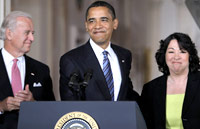BROWSE BY CATEGORY
- Archives and Libraries
- Blogs and Networking
- Bookmark This
- Digital Tools
- Examples of Teaching
- Exhibits
- Film Reviews
- History and Headlines
- Historic Sites and Museums
- Historical Thinking
- Holidays and Heritage
- Issues and Research
- Lesson Plans
- Material and Visual Culture
- Multimedia
- Organizations and Agencies
- Primary Sources
- Professional Development
- Publications
- Student Activities
- Teaching Materials
- Websites
The Supreme Court: Connections Between Past and Present

On May 26, 2009, President Obama nominated Judge Sonia Sotomayor to replace retiring Justice David Souter on the U.S. Supreme Court.
The Senate Judiciary Committee is likely to hold hearings on her nomination in July and to seek a confirmation vote in Congress before the August 8 summer recess. If confirmed, Sotomayor would be the third woman on the Supreme Court and the first Hispanic justice, but how important are gender and ethnicity to the selection and approval process?
In The New Republic, columnist Tom Goldstein sketches the likely arguments for and against her confirmation. "Overall, the White House's biggest task is simply demonstrating that Judge Sotomayor is the most qualified candidate, not a choice based on her gender and ethnicity. The public wants to know that her greatness as a Justice is informed by her personal history and her diversity, not that it is defined by those characteristics," he points out.
At the top of her class at Princeton University and editor of the Law Journal at Yale University, Judge Sotomayor has been a prosecutor, private litigator, trial judge, and appellate judge. For more than a decade, she has served on the United States Court of Appeals for the Second Circuit which incorporates Connecticut, New York, and Vermont. As an appellate judge, she reviews decisions of District Courts for errors of law. Read sample cases she has adjudicated during her tenure as a member of the court's three-judge panel.
The judicial system is perhaps the least understood and most complicated among the three branches of U.S. government to explain and to teach.
To place Sotomayer's appellate experience in the context of the judicial system, visit U.S. Courts for an explanation of the structure of the American court system and the responsibilities of each kind of court. The Wikipedia entry, United States Courts of Appeals, also gives a helpful overview of the role of the functions of these courts and of how to find further documented information.
In a review of books about the Supreme Court at History News Network (HNN), historian Peter Hoffer explains why we need to understand the history of the Supreme Court. (Search HNN for other current and historical analyses of the role of the Supreme Court and specific decisions.) Hoffer writes,
. . . a history of the Court is essential because its operation is often obscure. The complexity of the cases the Court chooses to hear and decide cannot easily be explained to lay people. The deliberations of the Court are kept secret and cloak its operation and thinking from our inspection. The arcane language of the law in its opinions adds another layer of incomprehensibility to the Court's operation.
And at Annenberg Media, the course Democracy in America includes the unit The Courts: Our Rule of Law, stressing how "we depend on our courts and the rule of law to resolve conflicts between citizens and the government and between and among citizens." Lesson plans, primary source documents, critical thinking activities, and readings explore the importance of the American legal system and of the role of courts in defining law.
A teacher-authored history of the Supreme Court, produced in conjunction with PBS station Thirteen/WNET New York, offers educators and advanced learners a series of essays giving a comprehensive overview of the Court, of major decisions, and of their context. Lesson plans link to online resources and incorporate primary source documents requisite to implement each lesson plan.
The Thirteen/PBS website evolving from the PBS series on the Supreme Court also includes multimedia presentations on court justices and major events in the Supreme Court's history. Lesson plans, games, interviews, and discussion guides provide a variety of materials for classroom use.
Other useful resources include
The Supreme Court Historical Society explains how the Supreme Court works and its history.
Landmark Supreme Court Cases provides teachers with a full range of resources and activities to explore the key issues of major court decisions and presents the Constitutional concepts around which they evolve.
The Supreme Court's website includes current as well as historic information and materials.